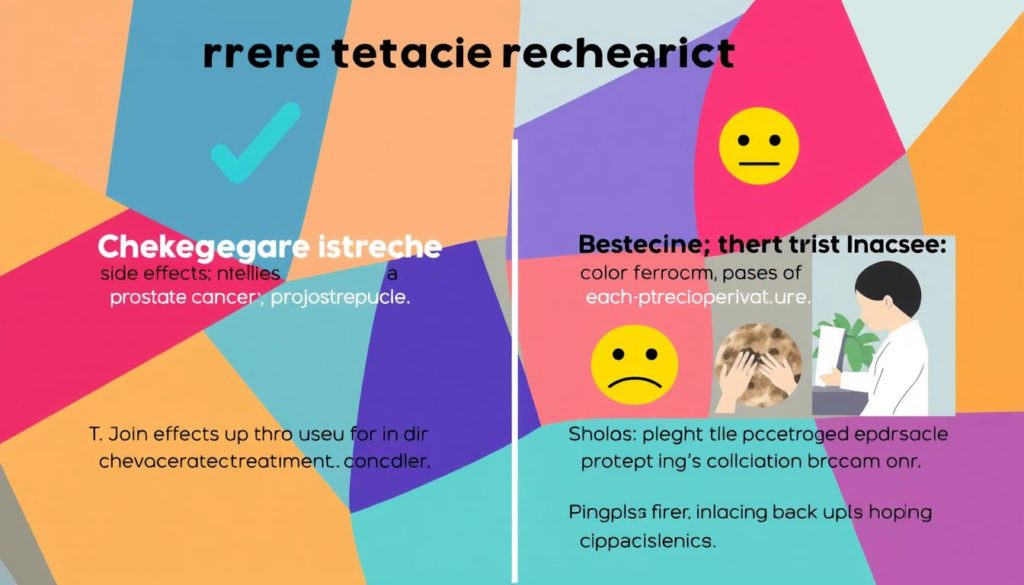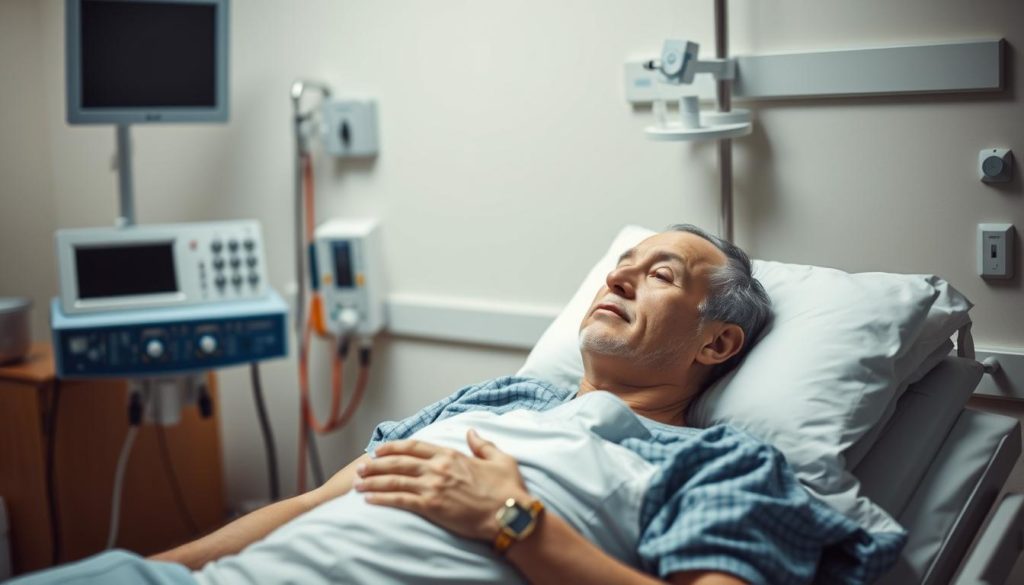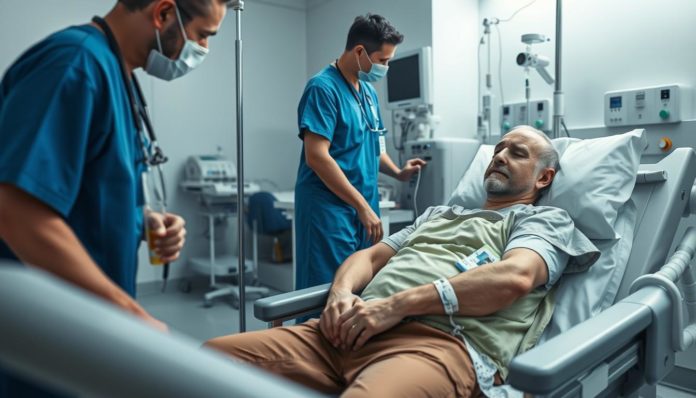About 1 in 9 men will face prostate cancer. For those with advanced stages, chemotherapy is key. It’s mainly used when the cancer has spread outside the prostate. This helps manage symptoms well.
Chemotherapy involves powerful drugs taken by mouth or IV. The aim is to kill cancer cells throughout the body. It’s vital when cancer does not respond to hormone therapy anymore.
Chemotherapy drugs like Docetaxel and Cabazitaxel help extend life and enhance its quality. Yet, these drugs also present challenges. Prostate cancer chemotherapy side effects happen because the treatment attacks fast-growing cells. This affects not just the cancer, but also cells in the bone marrow, stomach, and hair.
Knowing the details of chemotherapy for prostate cancer helps patients and families deal with the disease. It’s important to understand side effects and when chemo is needed. This information is crucial for effective disease management.
Introduction to Chemotherapy for Prostate Cancer
Chemotherapy is a powerful way to fight cancer cells. It’s key in treating prostate cancer, offering options to stop tumors and ease symptoms. Though not a sure cure, these drugs help a lot when used with other treatments. Knowing about these drugs helps patients and those caring for them make smart choices.

What is Chemotherapy?
Chemotherapy uses special drugs to stop cancer cells from growing and dividing. These drugs target cells that multiply quickly. They can make tumors smaller, slow down the disease, and help with pain and other problems. Depending on the person and the stage of cancer, treatment can be tailored.
How Chemotherapy Works
Chemotherapy targets the life cycle of prostate cancer cells. The drugs chosen aim to hit cancer hard but spare healthy cells when possible. Given in cycles, this treatment lets the body recover between sessions. This helps prepare for more treatment later.
This approach is well-thought-out to give the best results for prostate cancer patients. Learning about these options and how they work can really help with healing and quality of life.
When is Chemotherapy Used for Prostate Cancer?
Choosing the right time for chemotherapy is key in treating prostate cancer. It is mostly used for advanced or metastatic prostate cancer. In these cases, the cancer has gone beyond the prostate.

Advanced and Metastatic Prostate Cancer
Chemotherapy is crucial for advanced and metastatic prostate cancer. It’s vital when the cancer spreads outside the prostate. It aims to stop the spread and help with symptoms, making life better for the patient.
Combination with Hormone Therapy
Combining chemotherapy with hormone therapy is also key. This mix is used when hormone therapy isn’t enough on its own. Together, they work better, slowing the cancer’s growth and easing symptoms.
Let’s look at when to add chemotherapy to the treatment:
| Condition | When to Use Chemotherapy |
|---|---|
| Advanced Prostate Cancer | When cancer goes beyond the prostate gland and spreads locally. |
| Metastatic Prostate Cancer | When the cancer reaches distant organs or bones. |
| Hormone-Resistant Cancer | When hormone therapy can’t control the cancer anymore. |
| AR-V7 Gene | For those with the AR-V7 gene variant, showing resistance to some treatments. |
Knowing how to use chemotherapy alone or with other treatments is essential. This is crucial for effective prostate cancer treatment.
How Chemotherapy is Administered
Chemotherapy for prostate cancer can be given in different ways. It depends on each patient’s unique situation and care plan. Let’s look at the usual methods more closely.
Intravenous (IV) Administration
IV chemotherapy is a common choice. It means the cancer-fighting drugs go right into your bloodstream. This is done in a clinic or hospital, watched over by medical staff. IV chemotherapy gets the drugs to cancer cells fast, which is a big plus.
Oral Chemotherapy
Oral chemotherapy is another route, where patients swallow pills like Estramustine. Taking pills at home can be easier and more flexible. This way, patients can keep doing their day-to-day activities while getting treatment.
Central Venous Catheters
Devices called central venous catheters, such as ports and PICC lines, are also used. They make the delivery of chemo drugs and blood tests easier. By using these, patients face fewer needle sticks. It ensures steady delivery of treatment too.
Common Chemotherapy Drugs for Prostate Cancer
When picking the right chemotherapy for prostate cancer, some drugs stand out. Docetaxel and cabazitaxel are often the top choices. Docetaxel is the go-to first treatment, often boosted by steroids like prednisone or dexamethasone. If docetaxel doesn’t work well, doctors usually turn to cabazitaxel.
Other key drugs for prostate cancer include Mitoxantrone, Estramustine, and Carboplatin. Here’s a brief comparison of these drugs:
| Drug | Usage | Common Combinations |
|---|---|---|
| Docetaxel | First-line treatment | Prednisone, Dexamethasone |
| Cabazitaxel | Second-line treatment | Prednisone |
| Mitoxantrone | Advanced cases | Corticosteroids |
| Estramustine | Hormone-refractory cases | Other Chemotherapy Agents |
| Carboplatin | Advanced disease | Other Chemotherapy Agents |
Finding the most effective chemotherapy for prostate cancer means customizing treatment for each patient. Starting with docetaxel then moving to cabazitaxel if needed offers a plan. This plan is aimed at getting the best results while caring for the patient’s health.
Cycles and Schedule of Chemotherapy Treatment
Chemotherapy for prostate cancer is given in cycles following a set plan. These cycles help doctors give the best care and watch how patients react. Each chemotherapy treatment schedule is carefully made. It balances the treatment’s power with the time needed for the patient to recover.
Duration and Frequency
The length and how often prostate cancer chemotherapy treatment cycles happen depends on many things. This includes the patient’s health, the drugs used, and how well the patient handles the treatment. Usually, cycles are every three weeks. But, some plans might need to be changed by the medical team for each patient.
Rest Periods Between Cycles
Chemo schedules include breaks between cycles so the patient can recover from side effects. These breaks are key to making the treatment work best while keeping bad effects low. Doctors keep an eye on the patient’s progress. They adjust the cycles to make the treatment as good as possible.
Here’s a look at a usual prostate cancer chemotherapy treatment cycle:
| Phase | Description | Duration |
|---|---|---|
| Treatment Period | Administration of chemotherapy drugs | 1-3 days |
| Rest Period | Recovery and monitoring of patient | 2-3 weeks |
A well-planned chemotherapy treatment schedule makes sure patients get needed care. At the same time, it helps their recovery. This planning is key to treating prostate cancer with chemotherapy.
Possible Side Effects of Chemotherapy
Getting chemotherapy for prostate cancer may lead to various side effects. It’s important to know these for the best care. Both immediate and lasting side effects can change a patient’s life. So, managing these effects during treatment is critical.
Short-term Side Effects
Some common early side effects of chemotherapy for prostate cancer are:
- Fever: This can happen as the body’s immune system gets weaker.
- Fatigue: Feeling very tired often can interfere with everyday life.
- Hair Loss: Losing hair is a noticeable side effect that might hurt self-esteem.
- Nausea and Diarrhea: Issues like nausea and diarrhea happen often.
- Neuropathy: This means feeling tingling or numbness because of nerve damage.
Long-term Side Effects
Lasting effects might stay long after treatment ends. One common lasting effect is peripheral neuropathy. It’s often linked to chemo drugs like docetaxel and cabazitaxel. There are also rare, serious risks such as leukemia from Mitoxantrone. So, it’s vital to keep watching for these long-term effects and handle them as needed.
Managing Side Effects
It’s key to handle side effects well to keep patients feeling good. Doctors may suggest medicines to help with nausea and fight infections. Tailored treatments, like physical therapy for neuropathy, can really help. Talking often with healthcare teams is crucial. This helps manage side effects well and ensures strong support.
Effectiveness of Chemotherapy in Prostate Cancer Treatment
Chemotherapy for prostate cancer mainly aims to increase survival times and better life quality. Though it’s not a cure, it plays a big role in managing advanced prostate cancer. It helps in making the disease easier to handle.
Two drugs, Docetaxel and Cabazitaxel, are especially effective. They slow down cancer’s growth and lessen symptoms like pain and trouble urinating. These drugs are key in treating prostate cancer comprehensively.
| Drug | Key Benefits |
|---|---|
| Docetaxel | Proven to extend survival rates; alleviates severe symptoms |
| Cabazitaxel | Effective for patients unresponsive to Docetaxel; reduces tumor growth |
These findings show chemotherapy’s big role in treating prostate cancer. It helps patients by controlling symptoms and living longer. This makes life better for those getting treatment.
Combining Chemotherapy with Other Treatments
Using different treatments together can improve prostate cancer therapy. Adding chemotherapy to radiation and surgery could lead to better cancer control. This can also help patients have better outcomes.
Chemotherapy and Radiation
Chemotherapy and radiation work as a team against prostate cancer. Chemotherapy makes cancer cells weaker. Then, radiation attacks them more accurately. This boosts the treatment’s effectiveness.
This duo helps control symptoms better and may help patients live longer.
Chemotherapy and Surgery
Combining chemotherapy with surgery helps a lot, especially in advanced cancer cases. Chemotherapy before surgery can shrink the tumor, making surgery easier and less invasive.
This approach also fights any leftover cancer cells after surgery. It lowers the chance of the cancer coming back and helps patients live longer.
| Treatment Combination | Benefits | Considerations |
|---|---|---|
| Chemotherapy and Radiation | Maximizes cancer cell destruction; Enhanced symptom management | Side effects of both treatments must be managed carefully |
| Chemotherapy and Surgery | Reduces tumor size; Targets residual cancer cells post-surgery | Requires coordination between medical teams; Careful postoperative care needed |
Prostate Cancer Care Team and Support
Dealing with prostate cancer can be tough and confusing. But, having the right team of experts can make things much easier. This team usually has oncologists, specialized nurses, pharmacists, and various support staff. They all work together to care for you in every way. They help in giving chemotherapy, managing its side effects, and providing emotional support. This ensures you get care that’s tailored just for you and truly helpful.
Oncologists are key in this team. They guide your treatment plan, keep an eye on your progress, and tweak your chemo as needed. Nurses who are trained in oncology are there to help you directly. They watch how you respond to treatment and teach you and your family how to handle side effects. Pharmacists play a big role too. They prepare your chemo drugs and give advice on how to deal with side effects and drug interactions.
Having support while going through chemo is crucial. It keeps you positive and committed to your treatment plan. Support staff like social workers, dietitians, and mental health pros form a network of care around you. They offer counseling, dietary advice, and help you face the mental and physical challenges of chemo. Good prostate cancer care is not just about medicine. It’s about having people to support you every step of the journey.
FAQ
What is Chemotherapy?
Chemotherapy, also called chemo, uses anti-cancer drugs to fight cancer in the body. These drugs can be given through an IV or as pills. It’s a key treatment for late-stage prostate cancer.
How does Chemotherapy work for prostate cancer?
Chemo drugs target and kill fast-growing cancer cells. In prostate cancer, it slows down the cancer’s growth. This helps improve the patient’s quality of life by easing symptoms when the cancer has spread.
When is Chemotherapy used in prostate cancer treatment?
It’s used for advanced or metastatic prostate cancer, especially when the cancer has spread. Doctors often pair it with hormone therapy. It’s also used when hormone therapy stops working.
What are the common chemotherapy drugs used for prostate cancer?
Key drugs include Docetaxel and Cabazitaxel, along with Mitoxantrone, Estramustine, and Carboplatin. Docs typically start with Docetaxel and a steroid. If it fails, they might switch to Cabazitaxel.
How is chemotherapy administered?
Chemo can be given through an IV at a clinic or hospital, or taken as a pill. Devices like central venous catheters make the process easier.
How often are chemotherapy treatments scheduled?
Treatments follow cycles, with breaks in between. They’re usually every 3 weeks. This schedule allows the patient to recover while keeping the treatment effective.
What are the short-term side effects of chemotherapy for prostate cancer?
Patients may face hair loss, nausea, vomiting, and fatigue. There’s also a higher risk of infection. This happens because chemo affects fast-dividing cells like those in your bone marrow.
What are the long-term side effects of chemotherapy for prostate cancer?
Long-term effects can include nerve damage from certain drugs. There’s a small chance of developing leukemia from Mitoxantrone.
Can chemotherapy be combined with other prostate cancer treatments?
Yes, it’s often used with hormone therapy, radiation, and surgery. Combining treatments can better control the cancer and improve outcomes.
What is the role of the prostate cancer care team in chemotherapy treatment?
The care team supports the patient through treatment. They include doctors, nurses, and others who ensure the treatment is effective and help with decision-making.
How effective is chemotherapy in treating prostate cancer?
Chemo can lengthen life, reduce symptoms, and enhance life quality for advanced prostate cancer patients. Though not a cure, it’s vital for managing symptoms and providing relief.


